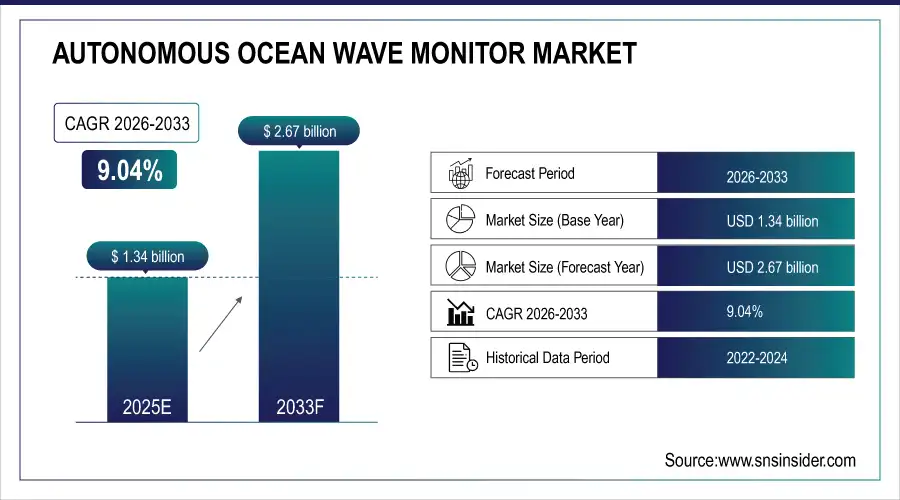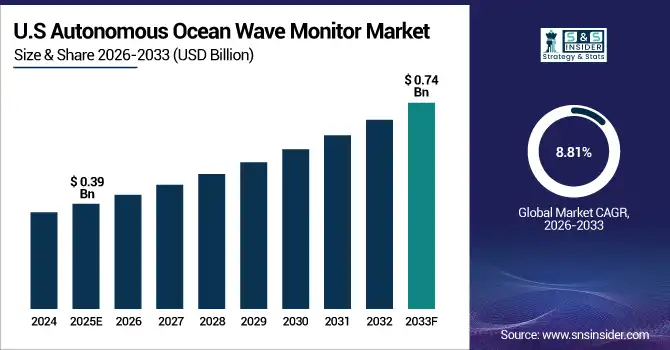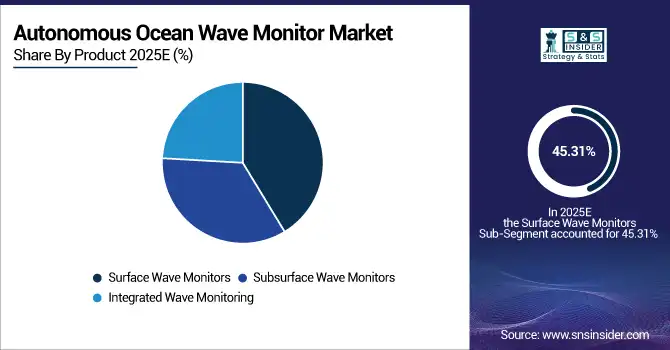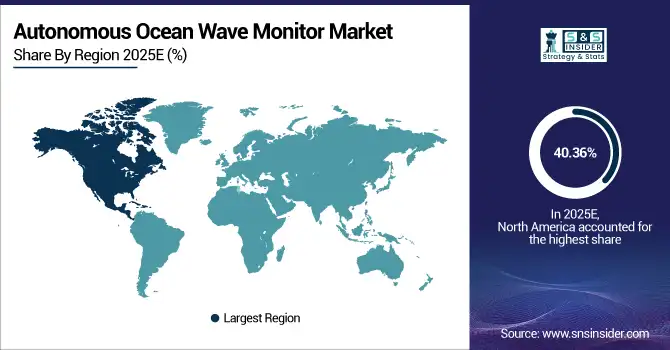Autonomous Ocean Wave Monitor Market Report Scope & Overview:
The Autonomous Ocean Wave Monitor Market size was valued at USD 1.34 Billion in 2025E and is projected to reach USD 2.67 Billion by 2033, growing at a CAGR of 9.04% during 2026-2033.
The Autonomous Ocean Wave Monitor Market analysis highlights the rise in adoption of advanced monitoring systems developed for coastal/ offshore and deep-sea operations is driving the market. Rising demand from oil & gas, defense and environmental research industry propels the market growth. The accuracy and efficiency of the method is improved with the aid of advanced arm sensors, IoT packaging and AI data analysis technology. Increasing sea and climate monitoring investments are also promoting worldwide market growth.
Environmental research institutions increased autonomous wave sensor deployments by 35% in 2024, driven by climate change studies and the need for high-resolution oceanographic data in polar and deep-sea zones.
Market Size and Forecast:
-
Market Size in 2025: USD 1.34 Billion
-
Market Size by 2033: USD 2.67 Billion
-
CAGR: 9.04% from 2026 to 2033
-
Base Year: 2025
-
Forecast Period: 2026–2033
-
Historical Data: 2022–2024

To Get more information on Autonomous Ocean Wave Monitor Market - Request Free Sample Report
Autonomous Ocean Wave Monitor Market Trends
-
The advent of autonomous wave monitoring systems in offshore energy, defense and environmental research is increasing operational efficiency, reducing human exposure to risk, and permitting real-time data acquisition.
-
Ground-breaking AI technology and IoT sensor devices improve predictive analytics, data precision and remote monitoring for wave-monitoring services worldwide.
-
Growing number of offshore Wind, Oil and Gas projects boost the demand for accurate wave monitoring solutions in order to optimize operations and secure crew safety.
-
Governments and research institutes deploy these autonomous wave monitors for coastal management, climate modeling, observing increasing sea levels and monitoring extreme weather events.
-
The advancement of multimodal, high sensitivity surface and sub-surface sensors to enhance the detection scope accuracy upholds integrated monitoring and leads to the expansion of the market in maritime services worldwide.
The U.S. Autonomous Ocean Wave Monitor Market size was valued at USD 0.39 Billion in 2025E and is projected to reach USD 0.74 Billion by 2033, growing at a CAGR of 8.81% during 2026-2033. Autonomous Ocean Wave Monitor Market growth is driven by offshore energy industry, surge in maritime safety awareness along-with rise in importance of defense applications. Significant government and research institution funding, coupled with the integration of AI-powered autonomous sensors and Internet of Things (IoT), promote real-time monitoring, efficiency in operations, and manageability of coastal environments.

Autonomous Ocean Wave Monitor Market Growth Drivers:
-
Increasing Demand for Autonomous Wave Monitoring Systems in Offshore Energy, Defense, and Environmental Research
The increasing number of offshore energy projects and maritime safety needs along with ongoing environmental studies are expected to further fuel demand for autonomous wave sensors in the ocean. Higher level sensors, AI based analytics and IoT integration allow for real-time data gathering and processing leading to efficiency in operations, minimizing human interaction and improved coastal protection. Ongoing innovation in technology continues to bolster market growth across commercial, government and research industries worldwide.
Over 80% of new offshore wind farms commissioned in 2024 deployed autonomous wave monitors to optimize turbine placement and ensure structural safety under dynamic sea conditions.
Autonomous Ocean Wave Monitor Market Restraints:
-
High Capital Costs and Complex Maintenance Limit Adoption Among Small and Budget-Constrained Organizations
Ocean wave monitoring autonomous systems, which provide a technological advance in this area,' are very expensive for small users and research institutions. Maintenance, calibration, and system integration also have cost implications. Deployment is also hampered by low technical capability in some areas, especially for offshore and deep-sea projects. These cost and operational challenges limit the growth of the market, particularly in developing markets.
Autonomous Ocean Wave Monitor Market Opportunities:
-
Integration of AI, IoT, and High-Precision Sensors Enhances Market Potential Globally
Growing use of AI-enabled analytics, connected via IoT, high accuracy surface and sub-surface sensors presents immense opportunities for growth. These tools are used for predictive modeling, remote monitoring and successful offshore (and island) operations. Increased investment in coastal protection, climate research and offshore energy projects also underpin growth. Market actors can use these trends to create new integrated, high commercial potential solutions.
In 2024, over 70% of new autonomous ocean monitoring systems integrated AI-powered analytics to enable real-time predictive modeling of wave patterns and extreme weather events.
Autonomous Ocean Wave Monitor Market Segment Analysis
-
By product, surface wave monitors led the market with a 45.31% share in 2025E, while integrated wave monitoring is expected to be the fastest-growing segment with a CAGR of 6.50%.
-
By application, environmental monitoring dominated the market with a 35.68% share in 2025E, whereas offshore energy is projected to grow at the fastest CAGR of 7.80%.
-
By component, sensors accounted for the largest share at 50.64% in 2025E, while communication systems are expected to register the fastest growth with a CAGR of 9.20%.
-
By end-user, government agencies held the largest share at 40.52% in 2025E, while research institutes are projected to grow fastest with a CAGR of 8.20%.
By Product, Surface Wave Monitors Leads Market While Integrated Wave Monitoring Registers Fastest Growth
Surface wave monitors have a large market share due to wide ranging applications in coastal monitoring, maritime navigation, and offshore energy. The reliability, precision and simplicity of use make them accepted almost wherever there is a need. Integration of wave monitoring services meanwhile is expected to post strong growth with demand additively increasing for a mix of surface and subsurface data, more advanced levels of automation, and real-time IoT-enabled monitoring. Increasing acceptance in research and defense industries along with offshore energy applications, is a key factor boosting the integrated wave monitoring market.

By Application, Environmental Monitoring Dominate While Offshore Energy Shows Rapid Growth
Environmental monitoring is the biggest market holder, as stand-alone wave meters are required for shoreline protection, climate studies mineral supplies and ecosystem maintenance. These systems are being used more and more not only by governments, but also by research institutions so as to produce accurate data. Increases are fastest for offshore energy applications, which are being driven by expanding wind, oil and gas projects. By measuring and forecasting wave conditions, you improve operational safety, effectiveness and uptime. The combination of high-accuracy sensors and real-time analytics also facilitates a quick transition into offshore energy markets.
By Component, Sensors Lead While Communication Systems Registers Fastest Growth
The sensors segment is leading in the market due to the sensors are an essential part of autonomous wave monitoring systems and these sensors provide precise surface as well as subsurface measurements. Advanced sensor technologies create better accuracy, durability and deployment efficiency. But fast dear growth is in the communication system segment, to satisfy an increase of remote data transfer demand and also due to the IoT integration and also real-time monitoring. Improved communication facilities supported the development of wave measurements systems more suitable for use offshore and in coastal or deep water where the requirements are very different from that on land, contributing to leading to technology being adopted worldwide.
By End-User, Government Agencies Lead While Research Institutes Grow Fastest
Government Agencies are major players in the market due to heavy investments made by them in maritime safety, coastal protection, and climate monitoring projects with widespread use of autonomous wave measurement systems. Research institutes are the most increasing end-use industry, utilizing these systems for academic research, environmental studies and offshore experimental projects. The momentum of closer government/research relationships and increasing investment in climate and marine research is facilitating fast take-up by research institutions across the globe.
Autonomous Ocean Wave Monitor Market Regional Analysis:
North America Autonomous Ocean Wave Monitor Market Insights
In 2025E North America dominated the Autonomous Ocean Wave Monitor Market and accounted for 40.36% of revenue share, this leadership is due to the trong growth in the autonomous ocean wave monitor market. The U.S. Navy is seeking to increase naval surveillance capabilities through improvements in underwater drones. Moreover, the Oil & Gas industry in the Gulf depends on Wave observations for marine offshore activities.

Get Customized Report as per Your Business Requirement - Enquiry Now
U.S. Autonomous Ocean Wave Monitor Market Insights
The U.S. has taken the lead in R&D and deployment for autonomous ocean wave height measurement systems, based on national defense, energy and environmental industries. Projects like the U.S. Navy’s Project Cabot seek to incorporate AUVs for surveillance.
Asia-pacific Autonomous Ocean Wave Monitor Market Insights
Asia-pacific is expected to witness the fastest growth in the Autonomous Ocean Wave Monitor Market over 2026-2033, with a projected CAGR of 9.86% due to rising investments in offshore energy projects and environmental monitoring programs. Compared to countries such as Japan and South Korea, which are at the forefront using advanced monitoring tools for their maritime sectors. There is also increasing demand for sustainable coastal engineering in the area.
China Autonomous Ocean Wave Monitor Market Insights
China is also a leading country that has adopted the measures of autonomous ocean wave monitoring, and it has invested heavily in marine infrastructure and environmental research.
Europe Autonomous Ocean Wave Monitor Market Insights
In 2025, Europe emerged as a promising region in the Autonomous Ocean Wave Monitor Market, due to a technological development in autonomous ocean wave observation. The French maritime agencies are employing autonomous technologies for environmental surveillance and protection of the coastline. Cooperation between members of the European Union is being developed to standardize monitoring technology and share data across member states, leading towards a holistic approach to maritime safety and research.
Germany Autonomous Ocean Wave Monitor Market Insights
Germany in autonomous ocean wave monitor market is expanding on account of defense technologies and environmental research. The country's defense start-up, Helsing is planning to deploy a flotilla of independent underwater drones featuring AI (artificial intelligence) to enable better naval monitoring.
Latin America (LATAM) and Middle East & Africa (MEA) Autonomous Ocean Wave Monitor Market Insights
The Autonomous Ocean Wave Monitor Market is experiencing moderate growth in the Latin America (LATAM) and Middle East & Africa (MEA) regions, due to the rising demand for better marine safety and environmental observation. Brazil, and South Africa are both developing coastal infrastructure and research program. The offshore in the Middle East’s oil and gas industry are dependent on accurate wave information. Collaboration between governments along with international collaboration are based on improving the way data is collected and shared in these areas.
Autonomous Ocean Wave Monitor Market Competitive Landscape:
Liquid Robotics builds autonomous surface vessels for gathering data from the oceans. Its Wave Glider platform provides the ability to sense and monitor the environment using real-time weather, wave and environmental measurements in both coastal and offshore waters. AI-based analytics and IoT-integration for the energy, defense and research industries.
-
In May 2025, Liquid Robotics launched the Wave Glider SV5, a larger uncrewed surface vehicle designed for extended maritime missions. At over five meters in length, it supports multiple payloads and operates efficiently in various sea states and weather conditions, including high latitudes and low-solar environments.
Sofar Ocean Technologies is the company behind autonomous ocean-monitoring instruments such as buoys and wave sensors. The company focuses on real-time data for weather forecasting, offshore energy and environmental monitoring. Its saleable and cloud-enabled platforms enable high-capacity maritime surveillance increasing operational effectiveness.
-
In June 2025, Sofar Ocean initiated an acoustic monitoring project near San Francisco Bay to protect humpback whales. The project utilizes Sofar's Spotter platform to collect real-time data on marine conditions, enhancing conservation efforts for these endangered species.
Teledyne Marine offers a variety of autonomous oceanographic products such as wave monitors, sensors, and underwater vehicles. The company delivers high-precision, reliable products to be used in defense, offshore energy sector and environmental applications. With integration of AI and IOT, it can do real-time analytics which is a bullet proof moon shot in the autonomous ocean wave monitoring space.
-
In June 2025, Teledyne Marine showcased its latest ocean mapping, acoustic, and AUV technologies at the SeaSEC Challenge 2025. The event focused on protecting underwater infrastructure in realistic maritime threat scenarios, highlighting Teledyne's advancements in underwater autonomy.
Fugro N.V. provides integrated autonomous ocean observation services, which include wave sensors, subsea instrumentation and data analytics platform. Its services underpin offshore energy production, maritime surveillance and environmental monitoring. Fugro’s worldwide reach and extensive offshore survey and monitoring capabilities enable it to provide real-time wave, current and other oceanographic information globally.
-
In September 2025, Fugro and NOAA Ocean Exploration signed a five-year Cooperative Research and Development Agreement (CRADA) to design and deploy remote and uncrewed technologies for deep-ocean mapping and characterization. This partnership aims to close critical data gaps in one of the least understood parts of our planet.
Autonomous Ocean Wave Monitor Market Key Players:
Some of the Autonomous Ocean Wave Monitor Market Companies are:
-
Liquid Robotics, Inc.
-
Sofar Ocean Technologies
-
Teledyne Marine
-
Fugro N.V.
-
Ocean Scientific International Ltd (OSIL)
-
Datawell BV
-
AXYS Technologies Inc.
-
Nortek AS
-
RBR Ltd.
-
Kongsberg Maritime
-
Seaview Systems Inc.
-
MetOcean Telematics
-
Develogic GmbH
-
CLS Group
-
EOMAP GmbH & Co. KG
-
HydroMet
-
Sonardyne International Ltd.
-
Valeport Ltd.
-
BioSonics, Inc.
-
Blue Ocean Monitoring
| Report Attributes | Details |
|---|---|
| Market Size in 2025 | USD 1.34 Billion |
| Market Size by 2033 | USD 2.67 Billion |
| CAGR | CAGR of 9.04% From 2026 to 2033 |
| Base Year | 2025E |
| Forecast Period | 2026-2033 |
| Historical Data | 2022-2024 |
| Report Scope & Coverage | Market Size, Segments Analysis, Competitive Landscape, Regional Analysis, DROC & SWOT Analysis, Forecast Outlook |
| Key Segments | • By Product (Surface Wave Monitors, Subsurface Wave Monitors, Integrated Wave Monitoring Systems), • By Application Environmental Monitoring, Offshore Energy, Coastal Engineering, Defense & Security, Research & Academia, Others) • By Component (Sensors, Data Loggers, Communication Systems, Power Supply, Others) • By End-User (Government Agencies, Research Institutes, Oil & Gas, Maritime, Others) |
| Regional Analysis/Coverage | North America (US, Canada), Europe (Germany, UK, France, Italy, Spain, Russia, Poland, Rest of Europe), Asia Pacific (China, India, Japan, South Korea, Australia, ASEAN Countries, Rest of Asia Pacific), Middle East & Africa (UAE, Saudi Arabia, Qatar, South Africa, Rest of Middle East & Africa), Latin America (Brazil, Argentina, Mexico, Colombia, Rest of Latin America). |
| Company Profiles | Liquid Robotics, Inc., Sofar Ocean Technologies, Teledyne Marine, Fugro N.V., Ocean Scientific International Ltd (OSIL), Datawell BV, AXYS Technologies Inc., Nortek AS, RBR Ltd., Kongsberg Maritime, Seaview Systems Inc., MetOcean Telematics, Develogic GmbH, CLS Group, EOMAP GmbH & Co. KG, HydroMet, Sonardyne International Ltd., Valeport Ltd., BioSonics, Inc., Blue Ocean Monitoring |

